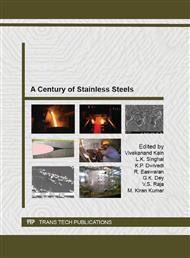p.351
p.358
p.366
p.375
p.380
p.391
p.415
p.429
p.441
Welding of Stainless Steel - A Heavy Engineering Perspective
Abstract:
Stainless steels are engineering materials capable of meeting a wide range of design criteria. They exhibit excellent corrosion resistance, strength at elevated temperature, toughness at cryogenic temperature and fabrication characteristics, and they are selected for a broad range of consumer, commercial, and industrial applications. In the fabrication of stainless steel products, components, or equipment, manufacturers employ welding as the principal joining method. Stainless steels possess good weldability and a welded joint can provide optimum corrosion resistance, strength, and fabrication economy provided reasonable care is exercised during welding. L&T's Heavy Engineering (HE) has established a reputation for quality products in the global market with its strong engineering capabilities and state-of-the-art manufacturing facilities. It manufactures and supplies various critical equipments like reactors, vessels, heat exchangers and inter-connecting piping to Fertilizer, Refinery, Petrochemical, Chemical, Oil & Gas, Power, Nuclear and allied Strategic sectors. The wide spectrum of equipments mentioned involves fabrication of various grades of Stainless Steel (SS)like Austenitic, Ferritic, Martensitic, Duplex, Super Duplex etc. This paper discusses some of the high productivity welding processes and the techniques being used in manufacturing Stainless Steel vessels at Larsen & Toubro’s Heavy Engineering such as: Narrow groove welding of high thickness SS joints by Submerged Arc Welding(SAW), High deposition SS weld surfacing using Electro Slag Strip Cladding (ESSC), Hotwire GTAW for joining & surfacing of SS, SS Liner welding by GTAW for critical Urea Service applications, Automatic Tube to Tube sheet Welding etc.
Info:
Periodical:
Pages:
380-390
Citation:
Online since:
September 2013
Authors:
Price:
Сopyright:
© 2013 Trans Tech Publications Ltd. All Rights Reserved
Share:
Citation:


